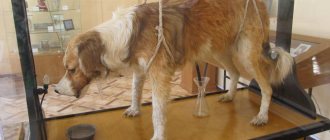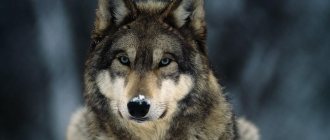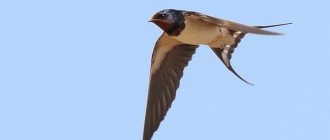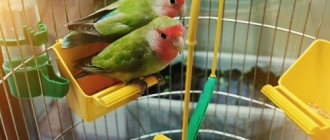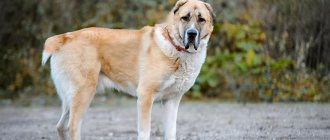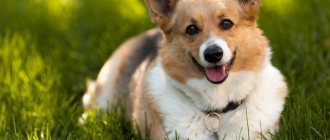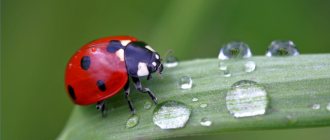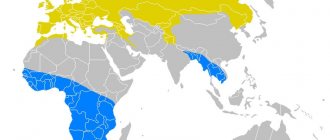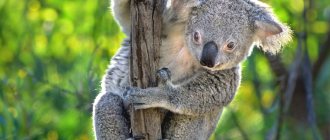- Wild animals
- >>
- Reptiles
The Komodo dragon is one of the most amazing reptiles on the planet.
The strong, unusually agile giant lizard is also called the Komodo dragon. The monitor lizard's external resemblance to the mythical creature is provided by its huge body, long tail and powerful bent paws. A strong neck, massive shoulders, and small head give the lizard a militant appearance. Powerful muscles are covered with rough scaly skin. The huge tail serves as a weapon and support during hunting and showdowns with rivals.
Origin of the species and description
Photo: Komodo dragon
Varanus komodoensis is a chordate of the class of reptiles. Belongs to the order Squamate. Family and clan - monitor lizards. The only one of its kind is the Komodo dragon. First described in 1912. The giant Indonesian monitor lizard is a representative of a relict population of very large monitor lizards. They inhabited Indonesia and Australia during the Pliocene period. They are 3.8 million years old.
The movement of the earth's crust 15 million years ago caused the influx of Australia into Southeast Asia. The transformation of the land allowed large Varanids to return to the territory of the Indonesian archipelago. This theory was proven by the discovery of fossils similar to the bones of V. komodoensis. The Komodo dragon actually comes from Australia, and the largest extinct lizard, Megalania, is its closest relative.
The development of the modern Komodo dragon began in Asia with the genus Varanus. 40 million years ago, giant lizards migrated to Australia, where they developed into the Pleistocene monitor lizard - Megalania. Megalania managed to achieve such an impressive size in a non-competitive food environment.
In Eurasia, remains of an extinct Pliocene species of lizard similar in size to modern Komodo dragons, Varanus sivalensis, have also been discovered. This proves that giant lizards thrived even in conditions where there was high food competition from carnivores.
Acquisition
It is better to make a purchase from experienced breeders who can advise, prompt and give answers to all questions that interest a beginner. It is necessary to understand the peculiarities of care and maintenance at home in advance and prepare the necessary equipment.
It is better to buy a Cape monitor lizard from breeders, since sellers in a pet store may not know all the nuances
When purchasing, always pay attention to the appearance and health of the young monitor lizard. If he is healthy, then this will certainly be reflected in his behavior - the monitor lizard will be inquisitive and active, and will try to free himself from the hands of the person who took him. If there are any problems, the lizard will be lethargic, indifferent and too calm, which should definitely alert the buyer. This behavior can be either a consequence of insufficiently high temperature and humidity in the terrarium, or the result of improper feeding.
An external examination of the body should not reveal any damage, scratches or abrasions. All claws must be intact, without cracks, have a natural bend and color. The oral cavity should be colored pink-lilac without any spots, dots or ulcers. If the color is dull gray or, conversely, bright red, then this indicates existing health problems. Such a reptile needs treatment and intensive care, which a beginner cannot provide.
The eyes and nostrils should also have no deviations. If, upon examination, the monitor lizard tries to escape, defends himself and hisses, then this is completely normal behavior of a healthy animal. It’s worse if he makes no attempts to free himself at all and is inactive.
Appearance and features
Photo: Komodo dragon animal
The Indonesian monitor lizard's body and skeletal structure resembles extinct ankylosaurs. A long, squat body elongated parallel to the ground. Strong crooked paws do not give the lizard gracefulness when running, but do not slow it down either. Lizards can run, maneuver, jump, climb trees and even stand on their hind legs.
Komodo dragons are capable of accelerating up to 40 km per hour. Sometimes they compete in speed with deer and antelope. There are many videos on the Internet where a hunting monitor lizard tracks and overtakes ungulate mammals.
The Komodo dragon has a complex coloration. The main tone of the scales is brown with complex inclusions and transitions from gray-blue to red-yellow. By color you can determine which age group the lizard belongs to. In young individuals the coloring is brighter, in adults it is calmer.
Video: Komodo dragon
The head, small compared to the body, resembles a cross between the head of a crocodile and a turtle. There are small eyes on the head. A forked tongue protrudes from its wide mouth. The ears are hidden in folds of skin.
The long, powerful neck extends into the body and ends with a strong tail. An adult male can reach 3 meters, females -2.5. Weight from 80 to 190 kg. The female is lighter -70 to 120 kg. Monitor lizards move on four legs. During hunting and showdowns over possession of females and territory, they are able to stand on their hind legs. The clinch between two males can last up to 30 minutes.
Monitor lizards are hermits. They live separately and unite only during the mating period. Life expectancy in nature is up to 50 years. The Komodo dragon reaches sexual maturity at 7-9 years of age. Females do not court or care for their offspring. Their maternal instinct is enough to protect laid eggs for 8 weeks. After the birth of the offspring, the mother begins to hunt for newborns.
Dimensions
Among the numerous varieties of monitor lizards, there are individuals that differ greatly from each other in appearance and size. Comparative characteristics of some representatives of monitor lizards are given below.
| Type name | Length, cm | Weight, kg |
| Striped | 250 | 30 |
| Blacktooth | 200 | 25 |
| Motley | 190 | 8,8 |
| Bengal | 175 | 7,2 |
| Black-throated | 150 | 5,5 |
| Indian | 100 | 3 |
| Short-tailed | 28 | 0,3 |
| Dwarf | 25 | 0,2 |
The table shows the average weight and body length of monitor lizards, since living conditions and the availability of sufficient food supply have a significant impact on the size of individuals.
Where does the Komodo dragon live?
Photo: Large Komodo dragon
The Komodo dragon has an isolated distribution in only one part of the world, making it particularly susceptible to natural disasters. The area of the habitat is small and amounts to several hundred square kilometers.
Adult Komodo dragons live primarily in tropical forests. They prefer open, flat areas with tall grasses and shrubs, but are also found in other habitats such as beaches, ridge tops and dry river beds. Young Komodo dragons live in forested areas until they are eight months old.
This species is found only in Southeast Asia on scattered islands of the Lesser Sunda Islands archipelago. The most densely populated by monitor lizards are Komodo, Flores, Gili Motang, Rinca and Padar and several other tiny islands in the surrounding area. Europeans saw the first giant lizard on Komodo Island. The discoverers of the Komodo dragon were shocked by its size and believed that the creature could fly. Hearing stories about living dragons, hunters and adventurers rushed to the island.
An armed group of people landed on the island and managed to get one monitor lizard. It turned out that it was a large lizard more than 2 meters in length. The following individuals caught reached 3 meters or more. The research results were published two years later. They refuted speculation that the animal could fly or breathe fire. The lizard was given the name Varanus komodoensis. However, another name has also been assigned to it - the Komodo dragon.
The Komodo dragon has become something of a living legend. In the decades since Komodo's discovery, various scientific expeditions from a number of countries have conducted field studies of dragons on Komodo Island. Monitor lizards did not go unnoticed by hunters, who gradually reduced the population to a critical minimum.
Coexistence with man
A natural question arises: can a Komodo dragon kill a woman, man or teenager? The answer, unfortunately, is yes. The mortality rate of a monitor lizard bite exceeds 90%. The poison is especially dangerous for a child.
But modern medicine has an antidote. Therefore, in case of an unsuccessful attempt to make friends with a monitor lizard, you should immediately go to the hospital. The death of a person from a bite is not such a common occurrence these days. As a rule, it occurs if a person hopes that he can cope with the illness. Doctors strongly recommend not to take risks; human immunity is not designed to withstand such stress as the venom of an exotic lizard.
This should be remembered not only by tourists, but also by those who decide to place an unusual pet at home. The intensive care unit of a district hospital may simply not have the necessary antidote, so a preliminary consultation with a competent breeder is extremely necessary.
What does the Komodo dragon eat?
Photo: Komodo dragon reptiles
Komodo dragons are carnivores. It was believed that they eat mainly carrion. In fact, they hunt frequently and actively. They ambush large animals. It takes a long time to wait for a victim. Komodos track prey over long distances. There are cases where Komodo dragons have knocked down large boars and deer with their tails. An acute sense of smell allows you to find food at a distance of several kilometers.
Monitor lizards eat prey by tearing large pieces of meat and swallowing them whole, while holding the carcass with their front paws. Loosely articulated jaws and expanding stomachs allow them to swallow prey whole. After digestion, the Komodo dragon disgorges the remaining bones, horns, hair and teeth of its victims from its stomach. After cleaning their stomach, monitor lizards clean their faces on grass, bushes or dirt.
The diet of the Komodo dragon is varied and includes invertebrates, other reptiles, including smaller dragons. Monitor lizards eat birds, their eggs, and small mammals. Their victims include monkeys, wild boars, and goats. Large animals such as deer, horses and buffalo are also eaten. Young monitor lizards feed on insects, eggs of birds and other reptiles. Their diet includes geckos and small mammals.
Sometimes monitor lizards attack and bite people. There are cases when they eat human corpses, digging up bodies from shallow graves. This habit of raiding graves caused the Komodo people to move graves from sandy to clay soil and place stones on them to deter the lizards.
Deadly poison
Powerful jaws, muscles and claws are not the monitor lizard’s only weapons. Unique saliva can be called a real pearl of the arsenal. It contains not only huge doses (probably obtained from eating carrion), but also poison.
For a long time, scientists were confident that the death of a bitten victim was due to simple sepsis. But recently the presence of poisonous glands was discovered. The amount of poison is small and causes instant death only in small animals. But the dose received is enough to trigger irreversible processes.
Monitor lizards are not only excellent tacticians, but also amazing strategists. They know how to wait, sometimes hanging around near the victim for 2-3 weeks and watching how she slowly dies.
Features of character and lifestyle
Photo: Animal Komodo dragon
Despite its enormous height and large body mass, the Komodo dragon is a rather secretive animal. Avoids meeting people. In captivity, it does not become attached to people and demonstrates independence.
The Komodo dragon is a solitary animal. Does not form groups. Zealously guards its territory. Does not raise or protect its offspring. At the first opportunity, he is ready to feast on the baby. Prefers hot and dry places. Typically lives in open plains, savannas and tropical forests at low altitudes.
Most active during the day, although it exhibits some activity at night. Komodo dragons are solitary, only coming together to mate and eat. They are able to run fast and skillfully climb trees when young. To catch out-of-reach prey, the Komodo dragon can stand on its hind legs and use its tail as a support. Uses claws as weapons.
For shelter, it digs holes 1 to 3 m wide using its powerful front paws and claws. Due to its large size and habit of sleeping in burrows, it is able to retain body heat during the night and minimize its loss. Knows how to camouflage well. Patient. Capable of spending hours in ambush waiting for its prey.
The Komodo dragon hunts during the day but remains in the shade during the hottest part of the day. These resting areas, usually located on ridges with cool sea breezes, are marked with droppings and cleared of vegetation. They also serve as strategic ambush spots for deer.
Captivity
Monitor lizards are one of the few reptiles suitable for home keeping. When purchasing and arranging a terrarium, it is necessary to take into account the size of the animal and whether it belongs to a steppe, arboreal or aquatic species.
Thus, the length of the terrarium should exceed the length of the reptile by at least one and a half times, while for desert species it is worth purchasing horizontal models, for aquatic species - cubic, and for arboreal species - vertical. Driftwood and stones are placed inside, and sand or fine gravel is used as soil.
Under natural conditions, most species live in natural areas with a warm climate, so the temperature in the terrarium should be maintained at 28-30 degrees.
Young reptiles are fed daily, from 6-7 months they begin to give food every other day, and at the age of 1.5 years the number of feedings is reduced to 2 times a week.
The most suitable for keeping in captivity are the spiny-tailed, blue-tailed, emerald, Timorese, Cape and other species of small monitor lizards.
GIRAFFE
Social structure and reproduction
Photo: Komodo dragon
Komodo dragons do not form pairs, do not live in groups, and do not form communities. They prefer an exclusively isolated lifestyle. They carefully protect their territory from their relatives. Other members of their species are perceived as enemies.
Mating in this species of lizard occurs in the summer. From May to August, males fight for females and territory. Fierce fights sometimes end in the death of one of the opponents. An opponent pinned to the ground is considered defeated. The fight takes place on the hind legs.
During battle, monitor lizards may empty their stomachs and defecate to lighten the body and improve maneuverability. Lizards also use this technique when running away from danger. The winner begins courtship with the female. In September, females are ready to lay eggs. However, in order to have offspring, females do not have to have a male.
Komodo dragons exhibit parthenogenesis. Females can lay unfertilized eggs without the participation of males. Only male cubs develop in them. Scientists suggest that this is how new colonies appear on islands previously free from monitor lizards. After tsunamis and storms, females, washed up on deserted islands by the waves, begin to lay eggs in the complete absence of males.
Female Komodo dragons choose bushes, sand and caves for laying. They camouflage their nests from predators who are ready to feast on monitor lizard eggs, and from the monitor lizards themselves. The incubation period of the clutch is 7–8 months. Young reptiles spend most of their time in trees, where they are relatively protected from predators, including adult monitor lizards.
general characteristics
Monitor lizards, which belong to the suborder of lizards, have a number of characteristic differences that distinguish them from real lizards in accordance with their body structure. So, the main features of monitor lizards include:
- The presence of a completely ossified skull, as well as movable jaw joints, thanks to which monitor lizards are able to swallow large prey.
- Inability to drop tail.
- Conical teeth with characteristic pointed edges.
- Four-chambered heart with two circulation circles.
Most varieties of monitor lizards are about 0.5-1 m long. Some varieties can reach sizes of 20 cm, for example, the short-tailed monitor lizard.
The Komodo dragon is considered the largest representative of its species: its length reaches 3 meters and weighs 140 kg. The giant size of the monitor lizard gave rise to its alternative name - the Komodo dragon.
Monitor lizards have a slightly flattened head, which is rounded in the front. Thus, their snouts are more snake-like than lizard-like. However, unlike snakes, monitor lizards have round pupils. They have a fairly thick neck, and their body is slender and strong. The limbs are well developed, they are five-fingered. The limbs themselves are in a bent position, and at the ends of the fingers there are long, curving claws. Monitor lizards also have a strong tail, which tapers towards the end and is only slightly longer than the body.
The tongue of lizards is long, mobile and forked, which is also considered a characteristic feature of snakes. With the help of their tongue, monitor lizards are able to sense smells at a considerable distance. Their teeth are replaced throughout their lives.
The color of monitor lizards is usually dull, but at the same time quite varied. Young lizards have a pattern consisting of stripes or spots, which disappears as they grow older. The characteristic colors for monitor lizards are gray, sand, and black shades. At the same time, there are also quite bright varieties of lizards.
The Emerald Monitor is the most colorful variety. This species lives in tropical forests, making green color an important element of its camouflage.
Monitor lizards differ from other lizards in their rather large size, as well as developed muscles. The paws of monitor lizards are tenacious and powerful, the stomach expands in the middle part. Although monitor lizards are not able to throw their long tail like other lizards, they can use it for attack and defense in case of danger.
Natural enemies of Komodo dragons
Photo: Large Komodo dragon
In its natural environment, the monitor lizard has no enemies or competitors. The length and weight of the lizard make it practically invulnerable. The only and unsurpassed enemy of a monitor lizard can only be another monitor lizard.
Monitor lizards are cannibals. As observations of the life of the reptile have shown, 10% of the diet of the Komodo dragon consists of its relatives. In order to feast on its own kind, a giant lizard does not need a reason to kill. Fights between monitor lizards are not uncommon. They can begin because of territorial claims, because of the female, or simply because the monitor lizard has not obtained other food. All clarifications of relationships within the species end in bloody drama.
As a rule, older and experienced monitor lizards attack younger and weaker ones. The same thing happens with newborn lizards. Small monitor lizards can become food for their mothers. However, nature took care of protecting the monitor lizard cubs. Teenage monitor lizards spend the first few years of their lives in trees, hiding from their stronger and stronger brothers of the species.
In addition to the monitor lizard itself, it is threatened by two more serious enemies: natural disasters and humans. Earthquakes, tsunamis, and volcanic eruptions seriously affect the Komodo dragon population. A natural disaster can wipe out the population of a small island in a matter of hours.
For almost a century, man mercilessly exterminated the dragon. People from all over the world flocked to hunt the giant reptile. As a result, the animal population has been brought to a critical level.
Mating games of titans
The monitor lizard who defeats his opponent can choose a girlfriend with whom he will have children. The pair will build a nest, the female will guard the eggs for about eight months, which may be encroached upon by small nocturnal predators. By the way, relatives are also not averse to enjoying such a delicacy. But as soon as the babies are born, the mother will leave them. They will have to survive on their own, relying only on the ability to camouflage and run.
Monitor lizards do not form permanent pairs. The next mating season will begin from scratch - that is, with new battles in which more than one dragon will die.
Population and species status
Photo: Komodo dragon in nature
Information on the population size and distribution of Varanus komodoensis has until recently been limited to early reports or surveys conducted over only part of the species' range. The Komodo dragon is a vulnerable species. Listed in the Red Book. The vulnerability of the species is due to poaching and tourism. Commercial interest in animal skins has put the species at risk of extinction.
The World Animal Fund estimates that the number of Komodo dragons in the wild is 6,000 lizards. The population is under protection and supervision. To preserve the species, a national park was created on the Lesser Sunda Islands. Park staff can accurately say how many lizards are currently on each of the 26 islands.
The largest colonies live on:
- Komodo -1700;
- Rinche -1300;
- Gili Motange-1000;
- Flores - 2000.
But it’s not just people who influence the state of the species. The habitat itself poses a serious threat. Volcanic activity, earthquakes, and fires make the lizard’s traditional habitat uninhabitable. In 2013, the total population in the wild was estimated at 3,222 individuals, in 2014 - 3,092, in 2015 - 3,014.
A number of measures taken to increase the population have almost doubled the number of the species, but according to experts, this figure is still critically small.
How to keep
At home, it is recommended to keep the monitor lizard in a horizontal terrarium, with approximate overall dimensions of 120x60x50 cm. Heating in the terrarium is mandatory. For this purpose, a thermal mat, thermal cord or heating lamps can be used.
Heating, during the period of activity of the monitor lizard, should not stop for 12 hours a day. At the same time, ultraviolet lamps must be turned on throughout the day. The air temperature during the day should be no higher than 28 degrees, at night – no higher than 20 degrees.
Maintaining the correct temperature regime is a prerequisite when keeping a monitor lizard at home. The approximate temperature of the warm corner should be about 30 degrees, under the heater - up to 40 degrees during the day, and at night - 25 degrees.
In order for the lizard to have the opportunity to warm up, you need to place a large stone, shelf or driftwood under the heating point. The bottom of the terrarium should be lined with sand, gravel, or small pebbles. It is recommended to spray the terrarium with warm water once a day.
Monitor lizards should be kept alone. In winter, monitor lizards hibernate; this must be remembered when keeping a lizard at home. At this time, the air temperature in the terrarium should be between 15 and 18 degrees. To maintain air humidity at the proper level, the soil should be sprayed once a week.
After the monitor lizard comes out of hibernation, it will need the same regime. Feeding, irradiation and heating of the terrarium will need to be carried out regularly. However, for the first few weeks after the lizard emerges from the state of torpor, its diet will need to contain food containing vitamin E.
